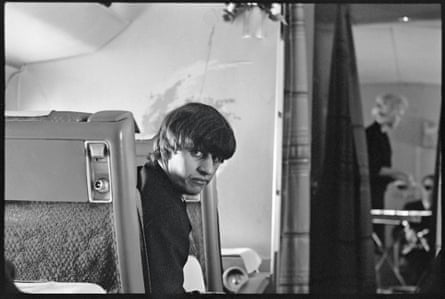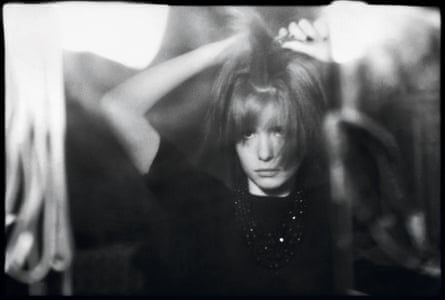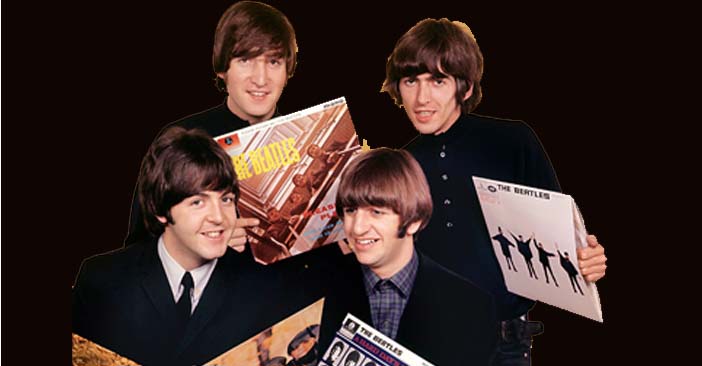
When asked "How do you find America?" Ringo Starr jokingly replied, "Turn left in Greenland."
The audience went into a frenzy as soon as they sang 'close your eye', the first words of the song, 'All My Loving', written by Paul McCartney and contained in their second album, 'With the Beatles' (1963).
The phenomenon called, 'Beatlemania', had begun to manifest itself since their arrival at Kennedy International Airport on February 7th. John Lennon, Paul McCartney, George Harrison and Ringo Starr were greeted by an army of photographers and thousands of hysterically screaming fans.
At 8 o’clock on February 9th 1964, America tuned in to CBS and The Ed Sullivan Show. But this night was different. 73 million people gathered in front their TV sets to see The Beatles’ first live performance on U.S. soil. The television rating was a record-setting 45.3, meaning that 45.3% of households with televisions were watching. That figure reflected a total of 23,240,000 American homes. The show garnered a 60 share, meaning 60% of the television’s turned on were tuned in to Ed Sullivan and The Beatles.

Sixty years ago this week, the Beatles were aboard Pan Am Flight 101 on their way to America for the first time – and all feeling thoroughly pessimistic about it.
The usually unflappable Paul McCartney nervously kept his seatbelt fastened throughout the journey. ‘They’ve got everything over there,’ he fretted to one of the journalists also on the plane. ‘What do they want us for?’
On November 22, 1963, a fusillade of rifle shots in Dallas, Texas, had ended the life of its inspirational young president, John F Kennedy.
As Flight 101 touched down on February 7 on a snow-flecked runway at newly-sanctified John F Kennedy Airport, an enormous crowd came into view around its main terminal building.
The Beatles, in their innocence, thought Kennedy’s successor at the White House, Lyndon Johnson, must also be expected that day.
They realised their mistake when they descended the aircraft steps to hear the crowd erupt into screams and (in those pre-airport security days) a hydraulic platform trundled across the tarmac towards them, festooned with shouting press photographers.
John had brought along his wife, Cynthia (the only time he ever would) in defiance of the rule that pop stars should stay unmarried and so theoretically be available to any one of their female fans.
Even so, Cynthia was under orders to remain as unobtrusive as possible, which sometimes meant appearing in public with a coat over her head like a crime suspect in custody.
Epstein had a secret of his own as a gay man in an era of rampant homophobia, who sublimated his adoration of John in an almost fatherly devotion to the Beatles as a whole. - Read the long full article on Dailymail.
‘Eyes Of The Storm’ Photo Exhibition To Open In New York.
“Since first arriving in New York in February 1964, Paul McCartney has built a strong, everlasting connection to the city.
‘Eyes Of The Storm’ makes its New York debut at the Brooklyn Museum, opening May 3, 2024, supported by Bloomberg Philanthropies. It is scheduled to run to August 18.
Captured by Paul using his own Pentax Camera, the exhibition features more than 250 photographs taken between November 1963 and February 1964, illuminating the period in which The Beatles became international superstars. The photographs were rediscovered in Paul's personal archive in 2020. Paul describes this collection as “the eyes of the storm,” chronologically documenting the experiences of the band on their travels beginning in November 1963 at the height of Beatlemania and culminating with photographs taken in February 1964 during the final days of the band’s first triumphant trip to America. Most of these photographs have never been made into prints, existing as negatives and contact sheets for 60 years until now.
"Suddenly, we were in Wonderland": Paul McCartney talks to The Guardian of his lost photos of BeatlemaniaSomewhere in the back of my mind, I always knew I had taken some pictures in the 1960s. At first, I couldn’t pinpoint the year, but I was certain we were quite young, just when the Beatles were really taking off.
I never tried to find this collection – consciously, that is – but I kind of thought that it would just surface at the right time. There’s often a certain amount of serendipity involved. And while we were preparing for an exhibition of my late wife Linda’s photographs in 2020, I learned that my own had been preserved in my archives. When I first saw them after so many decades, I was delighted that these images and contact sheets had been finally located. (Excerpt from the Guardian)

This was exactly my experience when seeing these photos, all taken over an intense three-month period, culminating in February 1964. It was a wonderful sensation because they plunged me right back.
Here was my own record of our first huge trip, a photographic journal of the Beatles in six cities, beginning in Liverpool and London, followed by Paris (where John and I had been ordinary hitchhikers just over two years before), and then what we regarded as the big time, our first visit as a group to America – New York, Washington DC and Miami – to the land where, at least in our minds, music’s future was being born.
In looking back at these photographs, I have even greater regard for the photographers around the Beatles back then. They would have to frame the picture, guess the lighting and then just go for it – the madness that enveloped us everywhere making their work ever more difficult.
Since we were surrounded by journalists, I often took pictures of them, not so much for revenge but because they were an interesting group of people. I would often say to them, “What’s the right lighting?”, because they were professionals and would automatically know.

Despite the simplicity of the camera, the process, at least to me, was challenging, since with each roll, you had only 24 or 36 images, which you had to get right, because there wasn’t a second chance.
This is such a contrast with the process today of taking pictures on your phone. You couldn’t be lazy then. You had to take the right picture, actually compose the image in the frame without the safety of knowing you could crop it later.
When I watched Linda work, she was very old school in that way. She had the discipline to spot the picture and then take it. She understood that she had only one opportunity and she had to get it right.
One of my favourite photos in the collection shows George Harrison, his face hidden by sunglasses, being handed a drink – probably a scotch and Coke – by a girl, and although we don’t see her face, we do see her dazzling yellow swimming costume.
The composition was deliberate, and I’m glad that I didn’t move further away but kept George as the focus of the image. In looking back on these photos of the good life, I’m not at all surprised that the colour pictures started happening when we got to Miami, because, suddenly, we were in Wonderland. Read the full article HERE
During this period Paul McCartney took lots of personal photographs that have never been seen before by the public. You can see the photos on Paul's Instagram profile
The personal archive will be displayed for the first time as part of a major exhibition to mark the National Portrait Gallery’s reopening in June.
A handful of unseen photographs taken by Sir Paul McCartney during the early days of The Beatles have been released ahead of his National Portrait Gallery display.
The archive features more than 250 images taken between November 1963 and February 1964 which capture the emergence of Beatlemania through the personal lens of Sir Paul’s Pentax camera. The exhibition is titled Paul McCartney Photographs 1963-64: Eyes Of The Storm

Previously unseen photos of the Beatles taken at the height of their stardom by Paul McCartney will go on display at the refurbished National Portrait Gallery in the summer. (NME)
The exhibition, Paul McCartney Photographs 1963-64: Eyes of the Storm, “will provide a uniquely personal perspective on what it was like to be a Beatle at the start of Beatlemania,” said Nicholas Cullinan, the NPG’s director.
1964: Eyes of the Storm will be published June 13 by Liveright.
Paul McCartney is releasing a photography book compiling 275 of his snapshots taken between the end of 1963 and the beginning of 1964—when Beatlemania was becoming a global phenomenon. 1964: Eyes of the Storm will be published June 13 by Liveright/W. W. Norton. The 35mm images are McCartney’s personal record of the time, and capture the Beatles’ travels through Liverpool, London, Paris, New York, Washington, D.C., and Miami. Watch a trailer for the book below.
“Anyone who rediscovers a personal relic or family treasure is instantly flooded with memories and emotions, which then trigger associations buried in the haze of time,” McCartney wrote in press materials. “This was exactly my experience in seeing these photos, all taken over an intense three-month period of travel, culminating in February 1964.”
It was a wonderful sensation to be plunged right back. Here was my own record of our first huge trip, a photographic journal of The Beatles in six cities, beginning in Liverpool and London, followed by Paris (where John and I had been ordinary hitchhikers three years before), and then what we regarded as the big time, our first visit as a group to America.
The photographs taken in this period captured the very moment that John Lennon, Paul McCartney, George Harrison, and Ringo Starr were propelled from being the most popular band in Britain to an international cultural phenomenon, from gigs in Liverpool and London to performing on The Ed Sullivan Show in New York to a television audience of 73 million people.
The 275 photographs were taken on 35mm film between December 1963 and February 1964 in a variety of locations, including New York, London, Washington, Miami, Paris and the band’s native Liverpool. McCartney thought he had lost them, but rediscovered them a few years ago.
The exhibition, Paul McCartney Photographs 1963-64: Eyes of the Storm, “will provide a uniquely personal perspective on what it was like to be a Beatle at the start of Beatlemania,” said Nicholas Cullinan, the NPG’s director [via The Guardian].
